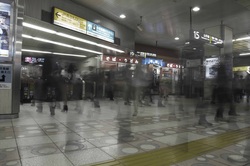
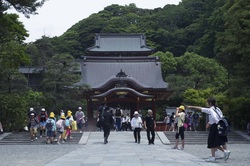
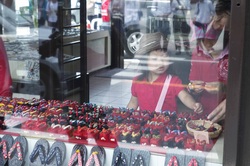
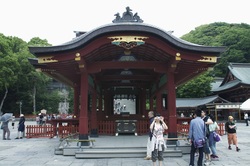
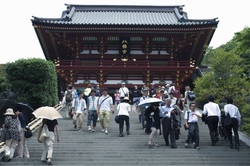
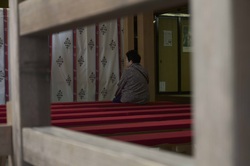
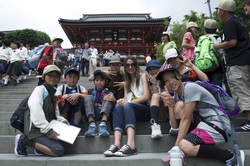

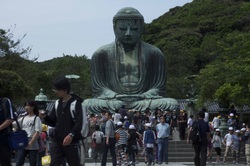
On Thursday May 31 our class embarked on a journey to Kamakura. The day included independent walking tours around some of Japan's most peaceful and most prominent ancient temples. Originally, we were supposed to have a full day in Kamakura, but the day was cut, our group needed to recuperate from the many straight days of walking from dawn to dusk along with little sleep. Because of this, our professor, Jonathan Martin, decided to give us a half day; the first stop on our list was Tsurugoaka Hachiman-gu, the most important shinto shrine in all of Japan. From here we had some lunch and shopping in Kamakura followed by a visit to Daibutsu, erected in 1252. The statue being over 40 feet in height, this Buddha shrine is a powerful site. We were left to stay at this location as long as we liked, walking around, viewing the sculpture and walking around in the extremely beautiful woods that surrounded the statue. Both of these powerful symbols were unbelievable, but unfortunately it seemed to be field trip day, hundreds of elementary school children were running around asking to take pictures with us almost at every minute. This made it a bit hard to concentrate on the powerful symbols that lay before me, fortunately the spaces in which these symbols occupied had peaceful areas (those being the woods, or a creek) that made it easier for me to find my "zen'. I did eventually find my inner calmness at both of these locations, although I did not find it while looking at the statues, as I would have hoped. That brings up the question to me of, did I find my inner peace because I was in the woods by myself or did these symbols somehow have a role in my finding of my "peace" although I may have not been directly looking at them. I do not know the answer to this question, but here are the pictures to prove it.  Shinkuju station, one of the largest subway stations in the world, here is my take on how I feel in this station  Tsurugoaka Hachiman-gu  Girl shopping in a store by Tsurugoaka Hachiman-gu, Kamakura  Tsurugoaka Hachiman-gu  Tsurugoaka Hachiman-gu  Lady praying inside Tsurugoaka Hachiman-gu  The distractions from me finding my "inner peace"  Shop owner, Kamakura  Daibutsu, Kamakura -Sean
0 Comments
Our group met at the front gates of the National Olympic Memorial Center at 7:15am this morning before meandering our way onto the overpass, across the train tracks, and through the local streets to Sangubashi station. Our first stop on today's expedition was to University of Tsukuba, one of Japan's oldest and best respected universities for science and social programs, including: architecture, engineering, and urban planning among others. Upon arrival, we were graciously welcomed by Dr. Murao Osamu whom provided an introduction to Japanese New Town planning of Tsukuba City followed by a cool video called ‘Tokyo Scanner’, that you can watch here: http://www.youtube.com/watch?v=ORc3gUhkwg4.
After the lecture, Murao Sensei brought us on several well planned and interesting tours, including but not limited to: the Tsukuba International Congress Center, Takezono Nishi Elementary School by Hiroshi Hara + Atelier, Kasumi Research and Training Center by Michael Graves, Soft and Hairy House by Eisak Ushida & Kathryn Findlay, Matsushiro Apartments by Hidetoshi Ohno, and the Tsukuba Center Building Complex. Each building and site embodied various architectural styles and designs that made for interesting consideration of comparison and differences for reference. At the end of the walking tours, we were escorted back to Tsukuba University for an architecture trivia game followed by drinks and hors d'oeuvres with other Tsukuba students and professors, that including a slideshow of images from the past few days as a friendly reminder of our shared experience. - Graham We were treated to an unnerving 2:00am wakeup call courtesy the rumbling earth, which was timely as yesterday's lecture by Dr. Nakai Norihiro at the Tokyo Institute of Technology was all about earthquakes and seismic activity. Our day of education began with an engaging lecture by Dr. Julian Worrall, Assistant Professor of Architecture and Urban Studies in the Institute for Advanced Study at Waseda University, Tokyo. In his presentation, titled "Tokyo: Architecture as Performance", Dr. Worrall explained his interest in using buildings as lenses to understand the character of individual cities as well as the values of the inhabitants. In Tokyo, he feels the buildings serve as a 'skin'--temporarily decorating the city until one by one they fall out of fashion and are torn down to be replaced by the next new style. The average lifespan of a building in Tokyo is twenty-six years, which means the vast majority of the city's population is older than the structures. This reflects a deep-rooted tradition of finding beauty in transience, as with the Sakura (cherry) blossom, which lasts a short time and then falls but is celebrated with picnics and a festival during its brief lifespan. Dr. Worrall led us on a walking tour of the Shiodome Shiosite (2005), a complex of thirteen sleek towers designed by a series of renowned international architects. Tucked along the outer edge is the Nakagin Capsule Tower, designed by Kisho Kurokawa (built 1972), which is a unique residential tower. This building serves as the first implementation of capsule living, in which tiny spaces just large enough for a bed are rented to businesspeople. Highly significant for the role it played in the history of architecture, this building is slated for demolition due to its aging facade and nearness to high-rent Shiodome. We took the elevated monorail to Odaiba, a part of the city situated on Tokyo Bay, which felt completely different from any other parts of the city we've visited. Akin to a kind of futuristic play land, it is filled with raised walkways, expansive vistas, paved plazas, lush plantings, and oversized structures. Fuji Television Building, designed by Kenzo Tange (built 1996) was our first stop, and after walking along an elevated plaza we climbed an enormous outdoor staircase of 135 steps (according to my count) just to reach the lobby level. The scale of this area combined with the unusual spatiality of heights was awe-inspiring. It felt like the ground didn't exist, or was so far below as to be out of one's conscious mind. Tokyo Big Sight (built 1996) was a short monorail ride away, and we were again overwhelmed by the monumentality and futuristic design of this convention center (annual host to 50,000 manga fans) made up of four upside-down golden triangles overlooking Claes Oldenburg's gigantic "Saw Sawing" (1996). Our final stop was Canal Court, designed by Toyo Ito (built 2005). This is the highly successful multi-family housing project in Shinonome. The buildings are constructed of high-quality materials, are well-landscaped and each has a slightly different design. The units include wall-size windows, and the complex boasts several daycare centers, cafes, and small shops. This model of providing high quality housing to low income families was financed by selling the outer lots to developers who built luxury condos on the land. Whether massive or tiny, Tokyo's buildings present us with constant contrasts.
-- Sara On the twenty-eighth day, of the fifth month, of the year two thousand and twelve a group of eighteen of my collogues and myself embarked on a journey through the small, narrow streets of urban Tokyo. We started the day off with an amazing and informative lecture from Norihiro Naki, Professor of Urban Planning at the Tokyo Institute of Technology where he informed us of the history of Tokyo’s development. After a brief and inexpensive lunch of sushi we eventually made our way to the streets, experiencing first-hand the amazing hidden sites the city had to offer. What follows is a series of images illustrating our slightly damp journey exploring urban spaces of all kinds. -Will
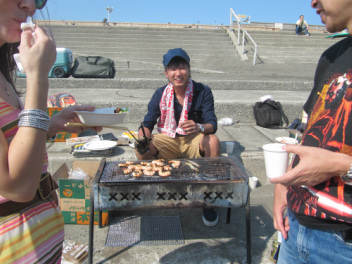 This is the a hybrid of nomu (drink) and communication. This explains the Japanese tradition of getting drinks after work with your co-workers. Why is getting together after hours for drinks so important to Japanese. Traditionally, in Japanese workplaces people have been expected to obey the hierarchy and all the accompanying etiquette. This includes not speaking one’s mind, and being careful to sugarcoat any, potentially offending comments. No human being can possibly handle the strain of being expected to keep such a tight lid on their thoughts and feelings a hundred percent of the time --- some kind of outlet is necessary. In Japanese society, if one is drinking, one is permitted to be more direct, and social faux pas that otherwise would be punished severely are tolerated. This is called Honne and usually takes place during a kind of party known as nomikai, when coworkers go to an izakaya (traditional bar) to chat, eat, and drink. This is when you can complain about your boss, or talk about your problems at home.
Today, Osamu Murao, of University of Tsukuba, invited us to Enoshima for a traditional Japanese style BBQ. We enjoyed a very relaxing day at the beach with an amazing spread of food prepared by students of Sam. The menu included grilled clams, fish, shrimp, and rice balls (yaki nigiri). We played the traditional game of suica wari, or watermelon crush. This is where one person is blindfolded,then they must spin around 10 times (on top of a sword), and then be guided towards the watermelon. Once the group screams go, the person swings the sword down to "crush" the watermelon. Earlier in the day we enjoyed a lecture by Benika Morokuma, on historic preservation in Kagurazaka, which is an area that was renowned for its numerous geisha houses, of which only 4 remain. The area is known for its roji streets, which is a term describing a narrow alley with a width of about 13 feet. They are made of pincora stone in the shape of a geisha's fan. This area is in danger because it has become a popular place to live. New setback lines are threatening to make the roads wider too. The current laws do not protect roji. Benika sensei is suggesting a system to preserve the roji, and the remaining geisha industry. This would preserve the common elements including the stone paving, the high walls on the front facade, vestibule gardens, shrubs, and the traditional Sukiya style architecture. We spent a short time there, and I think we all could recognize how special this place is and how necessary it is to preserve it. Early this morning Brad from the wireless company came to our hotel to fix our wireless connections. We were all very impressed with this type of customer service. He was very apologetic, and without question refunded the charge for the days that it did not work. We learned that he is from Canada and first came to Japan on a trip before college. He went to college and took Japanese classes, and has now been living here for 20 years. I hope that in 20 years one of our group will be saying this too. -Karen “When you’re travelling, every night the air is clear and crisp, the mind serene (…) day had turned to night and night was passing in the same way all over the world.”
Mikage Sakurai (Kitchen) Except on us, night did not pass for us. We woke up in New York on Thursday May 24th and found ourselves in Tokyo on Friday May 25th. Challenging the Earth’s rotation we crossed one day off the calendar without going through darkness and, the bad part about it, without sleeping. We are eighteen students from Pratt Institute traveling to Japan for eighteen days. This first blog is supposed to narrate the first day of our trip, ironically we don’t know where that day went, we mysteriously lost it somewhere in the Pacific Ocean. I could try to make the regular airport experience sound somehow entertaining. Luckily, and I am sure our professor Jonathan Martin is very happy about this, no one was late for the flight, forgot their passport or lost their luggage. Therefore, you can imagine the normal: waking up on Thursday, after our last Pratt Manhattan session (and maybe a beer… or two) and going to JFK to check in. We traveled on two different flights (one on AA and one on JAL). I can account for the AA flight, good movies, not as much turbulence and not as bad food. JAL passengers, you can brag about your good service in the future. What I want to try to do is go back to the words Banana Yoshimoto put on Mikage’s lips in the novel Kitchen: “when you’re traveling, every night the air is clear and crisp, the mind serene”. I can’t guarantee the serenity of our minds. Among the eighteen of us there are planners, cinematographers, preservationists, fashion designers and architects. We are going to Tokyo with a very specific challenge: document public space. As intense as this task will be I want to join Mikage in this serenity of mind. I want to experience the clear and crisp air of Japanese nights. I want to merge with every Mikage walking the streets of Tokyo. I want to understand both, the physical configuration of the Japanese public space and the magic and strength behind the culture that has built and rebuilt its city after floodings, earthquakes, fires and wars in an unconventional elegant and creative way. We will recover our lost day on our way back to New York, time is a dimension we can’t scape from and the motor of our cities. But before that happens, you will hear from each one of us. As days go by, adventures will accumulate, personalities will be revealed and Tokyo will never be the same in our minds (and yours). Follow us and help us turn this blog into the most public of spaces. Sayonara! Isabel 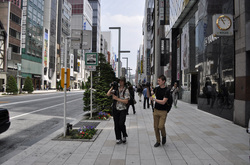 Under a remaining influence of the jet lag, we opened our Tokyo stay with a trip to Ginza, a downtown of the city, where many designer stores have their flagships, and streets resemble the look of 5th Avenue in New York City. Yet to our surprise, the city scale felt really "human", which in planer-ly language means, creating a sense of comfort and adequate to human being proportions. We have noticed that the main and the side streets create hierarchy extenuated by different dimensions as well as material used in the street design. Oh, by the way, the streets in Tokyo, most of the time, have no distinguishing names, directions are determined based on the relationship with other places. We have found some pretty amazing elements of the street like: functional flowerbeds/seating spaces, high end buildings, interesting sidewalk patterns as well as this, quite an awe creating pedestrian crossing. 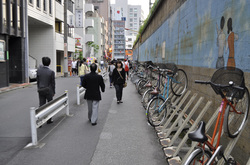 We also saw those interesting bike racks (and even bike parking!!!) nearby the Edo museum. Some bike parking is being created under elevated railways or withing other underutilized utility spaces. Once we met with Osamu Murao,of University of Tsukuba, , we visited a memorial-cementery for the victims of the 1923 great Tokyo fire. The 1923 Kanto Earthquake Memorial is designed (1930) by Chuta Itoh. The museum sits in Yokoami-kōen (Yokoami Park), with other memorial buildings and a garden dedicated to quake victims. A pleasant walk connects the park and the Ryōgoku Kokugikan through the Yasuda garden, once the site of the Edo home of a daimyō. 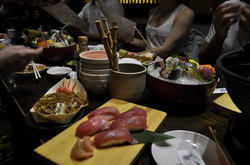 After a long day of walking within the Tokyo urban spaces, we got treated with some delicious food at a sumo restaurant, and yes, there are sumo tournaments that you can watch while you eat your meal.
|